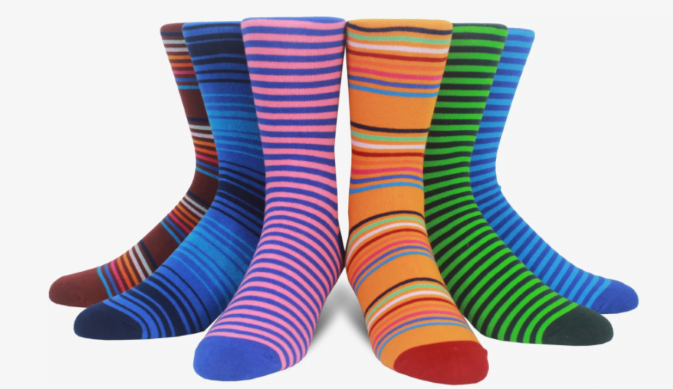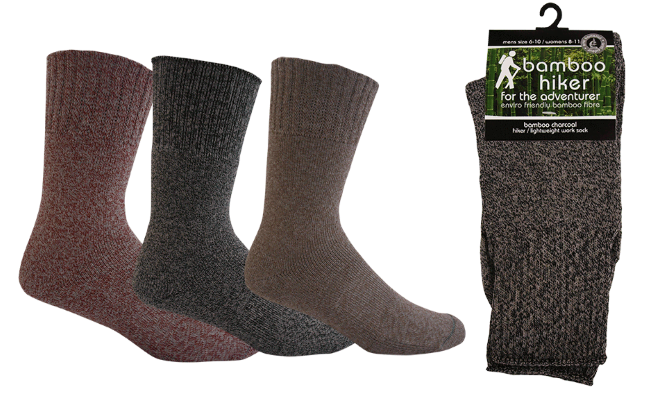
How to choose the right hiking socks | Auswalk
Socks play an important role in providing both comfort and protection for your feet and ankles on and off the track.
The walk or trek length can vary significantly, but the average number of steps, 1250 per kilometre doesn’t, so having the correct footwear combined with the right padding in your socks is crucial. Not only do socks prevent the accumulation of blisters (the number one factor leading to the downfall of any walk or hike), they also reduce the likelihood of foot odour. You don’t want to be the one remembered for your smelly feet after a long day of walking!
There are a few factors that need to be considered when choosing the right type of socks for hiking:
Sock height/length
Depending on your desired footwear and choice of pants/shorts the correct sock height will protect you from potential blisters/cuts from your footwear and the external environment as in low heath or bushes, twigs, insects, etc. When deciding on whether to purchase ankle socks, mid-rise or knee-length socks, ensure you first determine the type of footwear you are wearing. If the ankle cuffs are higher on your hiking shoes, then you will most likely opt for a longer sock to protect your skin from chafing from rubbing on your footwear.
There are 4 different styles when it comes to the length of socks:
- No-show socks: These socks cannot be seen whilst wearing shoes and therefore, provide little protection from rubbing on the ankle and foot. It is suggested that these socks are only beneficial for light walking and trail-running with low rise footwear.
- Ankle socks: Providing slightly more protection than no-show socks, the ankle sock typically covers the ankle bone and is best worn with low-mid cut shoes.
- Crew socks: Known as the most standard hiking sock, these socks sit above the ankle bone to protect your ankles from higher cuff boots. The versatility of these socks is far greater than the previously suggested as they can be worn with low, mid and high cut boots.
- Knee-length socks: These are essential when wearing hiking boots, like the one-piece leather Scarpa’s and for activities such as mountaineering. Knee-high socks are also a great option for trekking on those rainy days where you are wearing shin guards or just wanting some extra warmth,
Sock fit
The fit of your socks is especially important as those that choose socks either too small or too big will have to manage potential rubbing, blisters, and intense pressure points. Ensure you base your sock size on the size of your foot and not your shoe size, as this can cause people to unintentionally size up or down. When you have the correct sizing, the socks should comfortably hug your foot without being too tight.

Sock padding/cushioning
To determine what type of padding you would like for your socks, consider how warm you want them to be and the thickness of the cushioning. Where and when you are walking will play a role in the type of padding you will need. Weather and terrain can be variable, and you will want to make sure your feet are properly protected. However, if your socks are too thick this may create too much warmth and result in excess sweat and friction whilst walking for long periods or at a quick pace.
There are typically three thicknesses available:
- Light-weight: Best for summer hiking
- Medium-weight: Great for both warmer and cooler climates
- Heavy-weight: Suits cooler climates; may have extra protection for extreme conditions such as Everest
It is best to trial what works best for you and to have a few options to choose from prior to commencing your hike.
Sock fabric
Hiking socks feature a variety of materials to achieve maximal comfort whilst walking. The specific blend of materials differs between brands, but is often made up of:
- Merino wool: Having a sock with a higher percentage of wool fabric is most desired as it helps to maintain an appropriate and comfortable temperature. When paired with some synthetic fibres these socks tend to be the most durable, and work best in diverse climates due to their fast action drying and lack the annoying itch that most wool socks have.
- Nylon: This synthetic fabric dries quickly and is durable which makes it great for hiking; this is why it is sometimes used as the base material in hiking socks
- Polyester: Another synthetic fabric that keeps your feet warm, prevents moisture and is fast-drying. When combined with both wool and other synthetic fibres such as nylon it creates a comfortable blend that provides optimal padding and warmth.
- Silk: Although silk provides ultimate comfort due to its lightweight fibres and soft texture. It is not as highly recommended for hiking as it is thin and less resistant to rubbing, weather and intense terrain.
- Spandex: The elastic nature of spandex helps to maintain the shape of the hiking socks so that they are long-lasting and worth their while.
Does colour matter when choosing a hiking sock?
Just like your hiking boots, it does come down to personal preference. There are often many options available, and this allows for freedom to choose as your heart desires. One thing to note is that darker colours are better at hiding dirt or stains which may be something to consider when walking through muddy and rugged terrain.

Is it beneficial to wear two pairs of socks?
Blisters or abrasions can be a huge downfall when on a long hike, especially a multi-day hike. This can set the tone for the entire walk, i.e make it an extremely painful exercise. Due to the fear of rubbing that boots can cause, many hikers choose to wear two pairs of hiking socks as a means of stopping any such rubbing from occurring.
Socks are a great source of protection when hiking, whether it be to pad out the space in your shoes to prevent blisters or to minimize the number of little insects that may attempt to get inside your shoes whilst walking.
Some hikers, however, choose to wear two pairs of socks for that extra warmth that’s needed when hiking in extremely cold climates. This is particularly important in the maintenance of body temperature and the prevention of frostbite in freezing conditions.
Aside from the above reasons for choosing to wear two pairs of socks, it all comes down to personal preference. But ensure you have got a few pairs to swap when doing a multi-day hike. If you however are prone to blisters, want that extra warmth or are doing a longer hike, then two pairs are recommended.
What are bamboo socks and are they good for hiking?
Although not specifically a hiking sock, bamboo socks offer the same support as a hiking sock whilst enhancing comfort. The organic make-up of the socks provide ultimate padding as well, removing the fear of bad smells at the end of the walk due to the breathable, non-odorous fibres used. These fibres are known as Bamboo Kun which has both antibacterial and anti-fungal benefits.
As opposed to normal cotton or wool socks, bamboo socks have mini holes and gaps that boast quick absorption and ventilation to regulate sweat whilst walking. The material redirects the moisture outwards so that it can evaporate, rather than being caught in the fabric and causing discomfort. Note: if they become very wet, bamboo socks can take a long time to dry out.

What our guides and walkers think about hiking socks
“Bridgedale, Coolmax, Smart wool and Wigwam are all good brands. They provide a mix of wool and synthetic which ensures good wicking of moisture away from hot feet. The Ininji liner socks have individual toes so less chance of rub and blisters between toes if this is an issue. Ininji also makes actual socks not just liners but tend to be too thin for my big hiking boots.”
– Merel (Guide)
“It is all down to personal preference: for some people 2 pairs works, whereas for others one pair is sufficient. It all depends how snug your boots are and what feet issues you have.”
– Marie (Guide)
“I have worn Columbia for years, comfortable and extremely hard-wearing. A podiatrist friend just put me onto these Steigen. You will not get blisters. Look them up.”
– Auswalk walker
Try out your new socks with us
So now you’ve got your socks sorted, time to book your trip! If you’d like a hassle-free walking adventure, with comfortable accommodation and good food at the end of each day, then why not go with Auswalk, with group-guided, self-guided or customised trips offering walking holidays available for itchy feet in Australia and all over the world.
Self-guided trips enable you to walk with whoever you want, and when you want. We organise everything, including the transfers along the track, accommodation, and meals. Our guided walks have professional and experienced guides that walk with you, seamlessly organising absolutely everything which makes for both a very informative and stress-free experience.
You can find out more about our walks here, or call us on (03) 9597 9767.



There are no comments, be the first to comment.